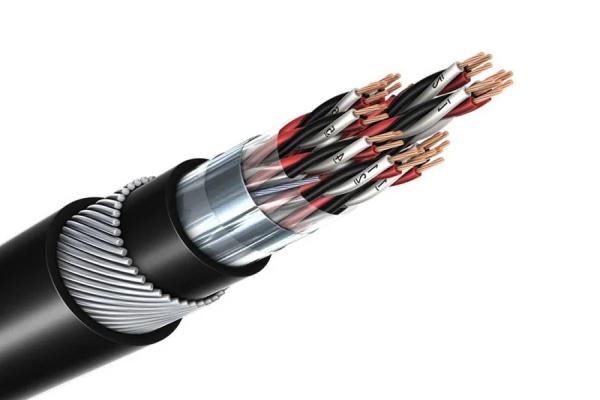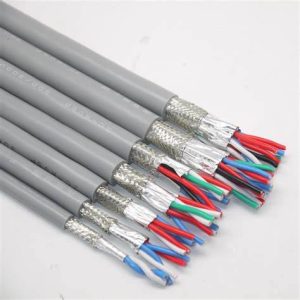

In der komplexen und anspruchsvollen Welt industrieller Prozesse, Eine zuverlässige Konnektivität ist von größter Bedeutung. Instrumentierungskabel spielen eine entscheidende Rolle bei der Gewährleistung einer nahtlosen Kommunikation zwischen verschiedenen Instrumenten, Sensoren, und Steuerungssysteme in industriellen Umgebungen. Diese Kabel wurden speziell für die genaue und effiziente Übertragung von Signalen entwickelt, auch unter rauen Bedingungen. In diesem Artikel, Wir werden uns damit befassen die Feinheiten der Instrumentierungskabel, ihre Typen erkunden, Anwendungen, und Bedeutung in modernen industriellen Setups.


Instrumentierungskabel sind ein spezialisierter Kabeltyp, der zum Übertragen von elektrischen Signalen mit geringer Energie von Sensoren oder Sendern zur Steuerung von Geräten oder Überwachungsgeräten verwendet wird. Im Gegensatz zu Stromkabeln, die so konzipiert sind, dass sie hohe elektrische Stromniveaus tragen, Instrumentierungskabel verarbeiten niedrige Spannungssignale mit Präzision und Zuverlässigkeit.
Diese Kabel bestehen normalerweise aus mehreren Leitern, normalerweise paarweise zusammengedreht oder Triaden, minimieren elektromagnetische Störungen (EMI) und sorgen für die Signalintegrität. Die Leiter sind häufig isoliert und abgeschirmt, um vor externen Eingriffen zu schützen und die Klarheit der Signal über große Entfernungen zu erhalten. Zusätzlich, Sie können verschiedene Rüstungs- und Manteloptionen bieten, um mechanische Schutz und Widerstand zu Umweltfaktoren wie Feuchtigkeit zu bieten, Chemikalien, und extreme Temperaturen.
Instrumentierungskabel sind in verschiedenen Arten erhältlich, jeweils auf bestimmte Anwendungen und Umgebungen zugeschnitten. Einige gängige Typen umfassen:
Diese Kabel enthalten mehrere verdrehte Leiterpaare, Jeder einzeln isolierte und farbcodierte für einfache Identifizierung. Multipair -Kabel sind vielseitig und in der industriellen Automatisierung häufig verwendet, Prozesskontrolle, und Kommunikationssysteme.
Triad -Kabel bestehen aus drei einzeln isolierten Leitern zusammen, die zusammengedreht sind. Sie sind besonders für Anwendungen geeignet, bei denen eine genaue Signalübertragung und Rauschimmunität kritisch sind, wie bei Temperaturmessung und Kontrollschleifen.
Panzerinstrumentationskabel verfügen über eine zusätzliche Schicht Schutzpanzerung, typischerweise aus Stahl oder Aluminium, sich vor mechanischen Schäden und Angriffen von Nagetieren zu schützen. Sie sind ideal für den Einsatz in robusten Umgebungen wie Industrieanlagen, Raffinerien, und Offshore -Installationen.
Diese Kabel sind so konzipiert. Sie werden mit Verwendung konstruiert Spezielle Isolier- und Mantelmaterialien das bietet Hochtemperaturwiderstand und niedrige Rauchemissionen, Gewährleistung des weiteren Betriebs in Notsituationen.
Verbundinstrumentationskabel kombinieren mehrere Funktionalitäten zu einer einzelnen Kabelstruktur, wie die Einbeziehung von Stromleitern neben Signalleitern. Dies optimiert die Installation und reduziert die Kabel -Unordnung, sie für räumlich begrenzte Umgebungen geeignet machen.
Instrumentierungskabel finden in einer Vielzahl von Branchen und Anwendungen eine umfassende Verwendung in einer Vielzahl von Branchen und Anwendungen, einschließlich:
In Fertigungsanlagen und Industrieanlagen, Instrumentierungskabel ermöglichen die Kommunikation zwischen Sensoren, Aktoren, Programmierbare Logikcontroller (SPS), und Übersichtskontrolle und Datenerfassung (Scada) Systeme. Sie ermöglichen eine Echtzeitüberwachung und Kontrolle von Produktionsprozessen, Gewährleistung einer optimalen Effizienz und Produktivität.
Im Öl- und Gassektor, Instrumentierungskabel werden in Bohrstors eingesetzt, Pipelines, und petrochemische Pflanzen, um Daten von Sensoren zu übertragen, die Parameter wie Druck messen, Temperatur, und Durchflussmengen. Diese Kabel halten heftigen Umweltbedingungen und gefährlichen Atmosphären wider, Bereitstellung einer zuverlässigen Leistung bei anspruchsvollen Offshore- und Onshore -Installationen.
Instrumentierungskabel spielen eine wichtige Rolle in der Stromerzeugungseinrichtungen, einschließlich Wärmekraftwerken, Wasserkraftdämme, und Installationen für erneuerbare Energien. Sie erleichtern die Überwachung und Kontrolle von Geräten wie Turbinen, Generatoren, und Schaltanlage, Helfen Sie den Betreibern, einen sicheren und effizienten Betrieb beizubehalten.
In Transportsystemen wie Eisenbahnen, Flughäfen, und Seehäfen, Instrumentierungskabel werden zur Signalübertragung in Steuer- und Überwachungsanwendungen verwendet. Sie ermöglichen den nahtlosen Betrieb von Signalsystemen, Ampel, und Überwachungskameras, Verbesserung der Sicherheit und Effizienz in Transportnetzwerken.
Innerhalb kommerzieller Gebäude und Infrastrukturprojekte, Instrumentierungskabel unterstützen Gebäudeautomationssysteme für HLK (Heizung, Belüftung, und Klimaanlage), Beleuchtungssteuerung, Zugangskontrolle, und Sicherheitssysteme. Sie ermöglichen eine zentralisierte Überwachung und Verwaltung von Aufbaufunktionen, Optimierung des Energieverbrauchs und Insassenkomfort.
Angesichts ihrer kritischen Rolle im Industriebetrieb, Die Qualität und Zuverlässigkeit von Instrumentenkabeln ist von größter Bedeutung. Kabel von schlechter Qualität können zu einer Signalverzerrung führen, Datenverlust, und Systemfehler, was zu kostspieligen Ausfallzeiten und Sicherheitsrisiken führt. Deshalb, Es ist wichtig, Kabel von seriösen Herstellern zu beschaffen, die sich an strengen Qualitätsstandards halten und robuste Herstellungsprozesse einsetzen.
Zusätzlich, Die ordnungsgemäße Installation und Wartung sind entscheidend, um die optimale Leistung und Langlebigkeit von Instrumentenkabeln zu gewährleisten. Installateure müssen den Best Practices und Richtlinien der Branche befolgen, um Signalstörungen zu minimieren, Kabelschäden vermeiden, und die elektrische Kontinuität aufrechterhalten. Regelmäßige Inspektionen und Tests tragen dazu bei, potenzielle Probleme frühzeitig zu identifizieren, Ermöglichen Sie bei Bedarf rechtzeitige Reparaturen oder Austausch.
Da sich die Technologie ständig weiterentwickelt, Instrumentierungskabel unterliegen auch laufende Fortschritte und Innovationen. Einige aufkommende Trends auf diesem Gebiet umfassen:
Mit dem Aufstieg der Industrie 4.0 und das Internet der Dinge (IoT), Instrumentierungskabel werden zunehmend in digitale Kommunikationsprotokolle und vernetzte Systeme integriert. Dies ermöglicht eine Echtzeit-Datenerfassung, Analyse, und Fernüberwachung, Verbesserung der Vorhersagewartung und der betrieblichen Effizienz.
Hersteller entwickeln Instrumentierungskabel mit verbesserter Haltbarkeit und Widerstandsfähigkeit, heftigen Umweltbedingungen standzuhalten, einschließlich extremer Temperaturen, Chemikalienexposition, und mechanischer Spannung. Fortgeschrittene Materialien und Konstruktionstechniken tragen zu einer längeren Lebensdauer und reduzierten Wartungsanforderungen bei.
Intelligente Instrumentierungskabel, die mit integrierten Sensoren und diagnostischen Funktionen ausgestattet sind. Diese Kabel können Änderungen der Temperatur erkennen, Feuchtigkeit, und Vibration, Bereitstellung frühzeitiger Warnanzeichen von potenziellen Problemen und Optimierung von Strategien zur Vermögensverwaltung.
Die Schwerpunkt auf Nachhaltigkeit und Umweltverantwortung bei der Kabelherstellung wird zunehmend betont, Förderung der Einführung umweltfreundlicher Materialien und Herstellungsprozesse. Recycelbare Materialien, Niedrigemissionsverbindungen, und energieeffiziente Produktionsmethoden tragen zur Reduzierung des ökologischen Fußabdrucks von Instrumentenkabeln bei.
Abschließend, Instrumentierungskabel spielen eine wichtige Rolle bei der Gewährleistung nahtloser Konnektivität und Datenübertragung in industriellen Umgebungen. Von Produktionsanlagen über Ölbohrinseln und Transportsysteme, Diese Kabel bilden das Rückgrat der modernen Infrastruktur, effiziente Kontrolle ermöglichen, Überwachung, und Automatisierung. Wenn sich die technologischen Fortschritte und die Anforderungen der Branche entwickeln, die fortgesetzte Entwicklung von hochwertiger Qualität, Zuverlässige Instrumentenkabel bleiben für die Stromversorgung der vernetzten Industrien der Zukunft von wesentlicher Bedeutung.
Wenn Menschen den Begriff mineralisch isoliertes Kabel hören, many immediately think of harsh environments like…
Wenn Telekommunikationsnetzwerke und Stromübertragungssysteme schnell wachsen, the demand for reliable and cost-effective…
In groß angelegten Öl- und Gasprojekten, Industriekabel sind nicht nur Zubehör—they are the "nervous…
In der Welt der elektrischen Verbindungen, Kabelschuhe—auch als Kabelohren oder Kabelklemmen bezeichnet—Sind…
Bei der Auswahl des richtigen Kautschukkabels für ein Elektrotechnikprojekt, it is critical to…
Liebe Partner und Kunden: 29. Januar, 2025 ist das chinesische Neujahr – Spring…